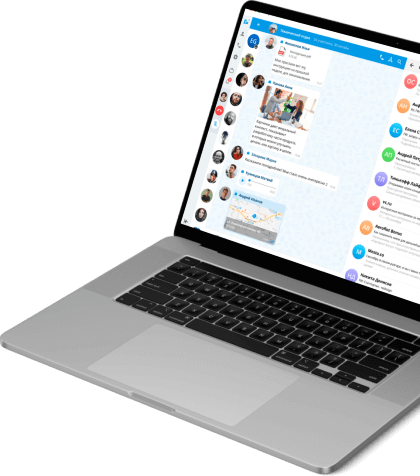Types of horizontal communications
Let's take a marketer and a sales department as an example. The marketer needs to transfer information about a new client who left a request on the site to the sales department. They need to interact periodically to discuss issues such as lead time or presentation content for customers in various industries. The problem may lie in the fact that employees are based in different offices or, for example, part of the team works remotely. Personal communication is still the main type of horizontal communication, but new ways of communication are also needed in many cases.
The most common modern types of horizontal communication in a company include:
1. Team or department meetings in videoconferencing.
2. Email. Everyone has long been accustomed to communication by mail, but it is also fraught with a trap - mail processing can take up to 20-30% of an employee's working time on average. In addition, mail is not suitable when you need quick feedback or discussion of individual tasks in the context of a common project.
3. Instant messaging platforms like eXpress, Slack or Microsoft Teams provide team members with a fast and efficient way to communicate with each other. By implementing an instant messaging tool, you can reduce the number of meetings and save team time, especially when you need quick (as opposed to the same mail) feedback. Among the convenient features of corporate messengers are threads, tags, chat bots and much more.
eXpress Enterprise Communications Platform
Your new level of enterprise mobility
- Enhanced data protection
- The only messenger class product certified by FSTEC
- Smart Apps Store

4. Social networking. Social networking platforms such as Vkontakte or TenChat can be used to facilitate peer-to-peer communication and collaboration.
5. Intranet (internal network) of a company can be used to increase employee engagement and be seen as a platform for interaction, exchange of views and information about the achievements of the company as a whole and individual employees.
6. Shared documents and file sharing systems allow team members to collaborate on projects, communicate faster with each other, and agree on important documentation.
The Benefits of Horizontal Communications
1. Pimproving the quality and efficiency of teamwork. Teams or departments within an organization are interdependent in terms of information exchange and collaboration, but they can be separated by hierarchical roles and regulations that overly formalize interaction. Horizontal communication is what helps to connect departments without too much bureaucracy.
2. Improved productivity. Teams that work well together can also identify and resolve issues faster, reducing downtime and improving overall efficiency.
3. Improving the efficiency of decision-making. Well-established horizontal communication ensures that all stakeholders receive the information they need to make informed decisions. When people at the same level communicate, they can collaborate to identify problems, evaluate alternatives, and develop solutions that serve the interests of the organization.
4. Enhancing overall creativity. When employees communicate horizontally, they can exchange ideas and perspectives, which can spur creativity and innovation. This can lead to new and better ways of doing business and ultimately to a more competitive organization.
5. Strengthening morale. Effective horizontal communication creates not only a sense of community among employees, but also allows you to more clearly reflect the contribution of each to a common cause. As a result, employees are more satisfied with their work, their optimism and enthusiasm increase. They are, as they say, "burning" with their projects and tasks.
How to build horizontal communications in a company
In order to build horizontal communications in the company, it is necessary first of all to determine the pool of those technological solutions that will be used for employee communication. If your company uses the recommended corporate messenger and video conferencing system, then it is important to notify all new employees about these tools so that they could immediately engage in corporate communication.
Regularity is important in horizontal communications. Schedule regular team meetings to discuss progress, exchange ideas, and receive feedback. Allow employees to work in cross-functional teams to increase access to different points of view. Also create opportunities for social interaction outside of work. This includes team building and various corporate events that allow you to “break the ice” between colleagues and build more trusting relationships.





